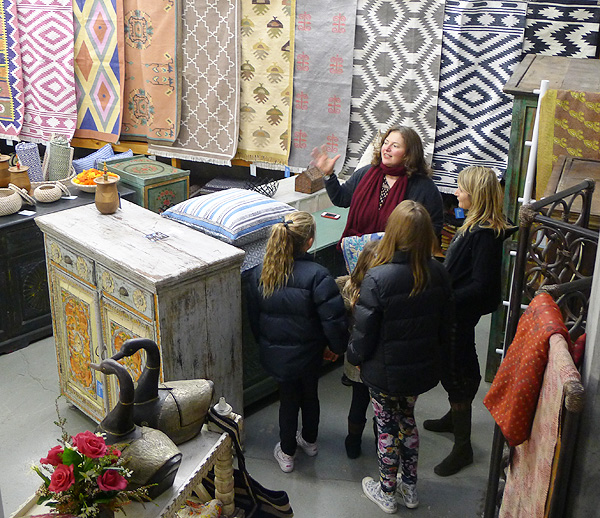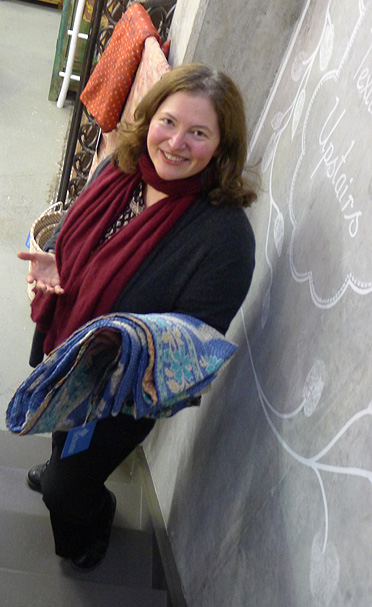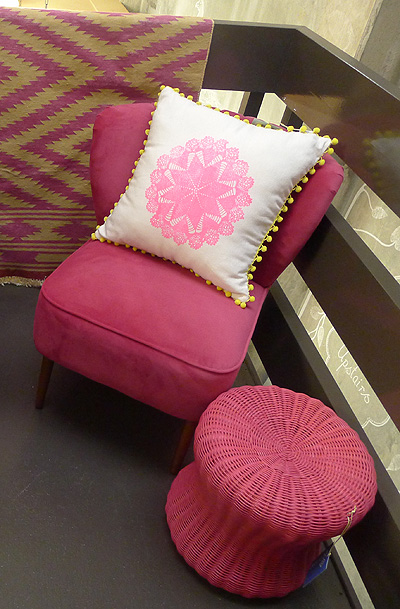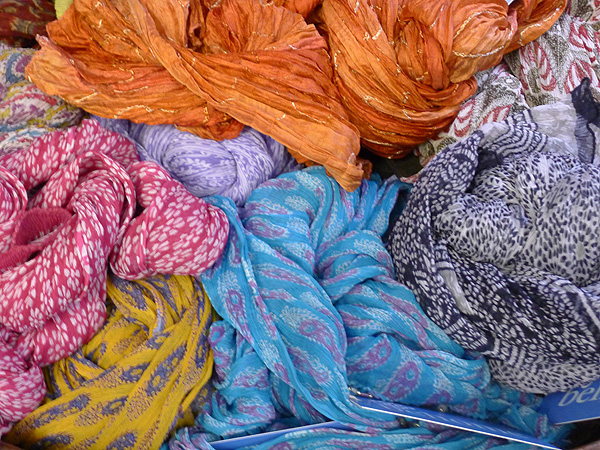The “Making It Happen” series is back online, conversing with Emily Davidow about moving to New Zealand and starting up a home design emporium.
Wherever I’ve lived, I’ve always been a “house†person, enjoying my (sometimes ill advised) attempts to decorate my abode. I’ve always enjoyed home stores, and they are dream businesses for many of us. “One with special things – the kind of things my friends really want,†we say, gazing off into the distant mists, visualizing a design boutique with all of our favorites, or an all-steampunk kitchen store. So it was a great pleasure to get behind the scenes of a delicious home design emporium with Emily Davidow.
“Emporium” is the right word for the variety at her retail space in Miramar, Behome. Two floors overflow with rugs, textiles, unique furniture, and even some well-chosen garments.
Growing up in the U.S.A., her family’s business was home furnishings. After successfully expanding the family business online in the 1990s, and other creative ventures, Emily decided that it was time for a major life change – moving from the U.S.A. to New Zealand. And that led to her opening up Behome in Wellington.
Read on to learn about her story, the vitality of beauty in the home, design Down Under, why things cost more in New Zealand, and good advice for your own business.
Why New Zealand?
Though New Zealand is often cropped off the edge of world maps, like a trailing semi-colon, or a printer’s error, the world would be wise to pay attention. For in both biology and society, the edge is the most innovative and generative place in any system.
Several years ago, I was living out my childhood dream of a big creative life in New York City, but yearning to be somewhere more peaceful and connected to nature. And thinking about the long view, if I was born today, where would I want to grow up? I realized that I could make anywhere with an internet home base. And if that was the case, what’s most deeply important? For me, it was fresh air, abundant water, great food, diverse and tolerant society, good education system, culture of peace, high connectivity, ease of doing business, creative arts scene, immersed in nature, surrounded by beauty, and preferably English-speaking.
People are always surprised to hear that Wellington reminds me of what I loved about living in New York City. They are both compact and diverse walking cities with creative arts and café cultures that encourage collaboration and serendipity. There’s a real heart to the city that I felt even on my first visit in the 1980s and am so happy to be home in today.
A lot of expatriates here comment on poor retail experiences – low selection, high cost – especially as women.
Interesting observation — there are two parts to your question to explore. First, the retail experience. At first, I was charmed by the retail clothing scene. There were so many distinctive New Zealand designers with their own points of view and very few international chains. Alas, so many have gone out of business in the past few years since I’ve been here. And yes, much of the retail experience is poor. On the one hand, it’s refreshing that shopping is not at the centre of the culture. On the other, it’s depressing when you need to buy something.
I would love to see the profusion of global online shopping available spark NZ retailers to excel and innovate rather than campaign for collecting GST on smaller purchases. Yes, we are competing globally, but that means we can also serve customers all over the world.
The second is “especially as women.†Even before I arrived, I was intrigued by New Zealand furniture design, such as David Trubridge’s iconic nature-inspired lighting and furniture, as well as Simon James, Nathan Goldsworthy and Rebecca Asquith and Tim Wigmore. Most of the home and furniture design here shares a sparse, minimalistic look — bare materials, clean, calm, neutral, masculine. I enjoy living with a lot of it, but balanced in a colourful, dynamic, inviting and soulful feast for all the senses.
And then there’s the retro elements. I think people turn to retro looks to get some femininity back.
Great point. Plus, there’s far more trade in used goods here. All that Art Deco furniture is still around. People here swap, it’s so filled with “op shops†– consumer goods have a much longer life in New Zealand. People make stuff, I really admire how hands-on people are, here.
What are some of the furnishings you remember from your childhood? It’s strange how some of these stick in the mind – I remember, as a child, wanting to cry when a large, comforting chest of drawers was moved one day. I also had an adversarial relationship with some 1970s glass tables.
One of my favorite early memories is of the faux-fur animal rugs or mats my parents had made up for my pre-school class. During nap and story-time, we gathered around in a circle on very faux tigers, zebras and bears. Their company at the time was called “Foam City,†and I remember a lot of 1970s foam furniture covered in crushed and groovy patterned velvets.
At home, we had a set of 4 bergère chairs around a large ottoman in the living room, which created a setting uniquely suited to conversation. They were re-upholstered many times, and I’ve ended up recreating that conversation pattern in all my homes since (with different styles of chairs).
I’ve furnished a house myself, a combination of used things and new. It’s a real frustration here, and you’re trying to give us an outlet for high quality home items at good prices. Things like wood furniture, woven rugs, stuff that really lasts. How are you able to do this?
I’m sourcing directly, traveling to the countries and developing relationships with the makers. This is the key to good prices, and also to making sure that means of production are excellent in terms of quality, environmental and social dimensions.
Can we talk about the ethics of your home furnishings? This is a hot topic for a lot of people.
That is a big part of my passion, too. I grew up in the home furnishings industry – when I was visiting furniture factories, I’d often feel faint, like my throat would be closing up, from the fumes. But consciousness about how toxic many processes were wasn’t there yet for the manufacturers or the customers. Now that we know a lot more, I want everyone involved to have a positive experience. Products should be made in a safe working environment, and enjoyed by customers in a healthy home. And the best way to create that change is to commission it. It’s powerful stuff.
Beyond non-harming, the items we choose to outfit our bodies and homes reflect our spirits and identity. Like people, objects have inner beauty (or not) inherited from the materials, conditions and energy of their creation. Real begins with the intention to make something well and honor nature’s gifts.
The name Behome comes from the universal human longing to be home wherever we find ourselves, and in ever growing awareness of the circles we call home, from our bodies, to our physical abode, to our communities, environment and world. The Greek word for home, oikos, refers both to our planetary home and the personal places we call home, where we belong and live our daily lives. Oikos is the root of ecology, ecosystems and ecological processes that renew life on earth. It’s also the root of economy, which refers to the management of the household. How did these two concepts become so separate? I’d like Behome to play a small part in weaving them back together, with products that make our homes more beautiful, joyful and alive now and and also contribute to a more beautiful world for our great-grandchildren’s great-grandchildren.
With your appreciation of New Zealand design, will you be trading in that, as well as the imports? Is it more affordable or more expensive?
I’m already working with New Zealand designers and suppliers on collaborative projects and am excited to develop more. Behome celebrates natural luxury, and NZ wool and wood are revered worldwide for their quality. Sadly, so much of the manufacturing that traditionally transformed these wonderful raw materials into their highest expressions has gone.
I keep going on about affordability because many New Zealanders often defer acquiring attractive home furnishings for years and years, first while they’re renting and then while they’re paying down a mortgage. But at the same time there’s this yearning for them, I’ve never seen so many interior design magazines. It’s very perplexing.
I’ve observed the same paradox you mention. Beauty and comfort contribute to the quality of our lives. Things don’t have to be expensive to be attractive and uplifting. Just one piece that you find beautiful, meaningful, delightful, or exceptionally well-made can completely transform a space. Surrounding yourself with colours and textures you love perceptibly improves your well-being and happiness.
Hire purchase is how I bought all my decent furniture. Will Behome have that?
Oh, yes, definitely! Furniture can be a major purchase and Behome would like it to be accessible to everyone. Financing is available through GE. We also encourage people to try rugs in-home for two weeks, as colour is very subjective and variable in different lighting.
I’ve heard about those North Carolina furniture mills. So they’re still there?
By the mid-2000s, most of our U.S. suppliers were manufacturing overseas, and the companies became just marketing shells. It’s become a very commoditized industry. What made the furniture business I grew up in so fun was the customization, the endless choices with bolts of fabric from small unique mills.
That’s a huge part of my inspiration. We celebrate handmade, artisanal, and custom design. We can make rugs in your colors, designs, and just the right size.
Do you have any advice to other people inspired to start up their dream businesses in New Zealand?
Go for it! We need more! Once you decide to do it, it’s amazing the people who help and the forces that unfold. Look at it as a great adventure.
How about getting started in e-commerce?
The tools available now are amazing. From hosted shopping sites and services to HD video from your mobile phone, to code that lets you paste transactional objects in blogs or social media. I’m excited by the new opportunities it creates for casual and playful online marketing — you don’t have to create an expensive full-blown destination site to get started. That said, great photography and quality copy really help to create a compelling experience.
Another area that’s getting easier is getting paid. One frustration, and reason things are more expensive here, is that banks and payment processors here charge more in fees than in the US; the lack of competition is not favorable to the small merchant. I’ve been watching innovative tools like Square and Stripe emerge in the US, and I’m excited to see Swipe launch here in NZ with a card reader that plugs into your mobile phone along with alternate merchant services for ecommerce websites.
Also, choose what you’re selling carefully. I am passionate about food that celebrates all the senses and connects us to the earth and each other, and researched starting a food business. Ultimately, I didn’t go down that path because of the low profit potential of the idea and high perishability of the products. Furniture has other issues, but it doesn’t expire, and people collect it over time.
And, it’s hard to download furniture…
True. Though you can already download furniture designs to print in a 3D fabricator or router for assembly. Exciting times! I’m interested in all the ways we can use technology and design to make a more beautiful world, and Behome will evolve as we learn. I feel really blessed to be able to do something I love in a place that I love.
Behome is open on Saturday 10-4, Sunday 12-4, and other days by appointment. Drop in and see the wonders at Behome:
6/131 Park Rd, Miramar, Wellington 6022
Phone: +64.4.388.5884





4 Comments